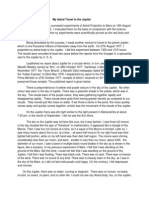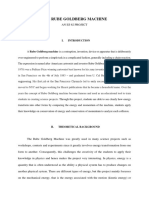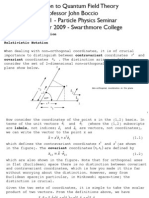0 ratings0% found this document useful (0 votes)
304 viewsRube Goldberg Machine
Rube Goldberg Machine
Uploaded by
api-248907105Copyright:
© All Rights Reserved
Available Formats
Download as DOCX, PDF, TXT or read online from Scribd
Rube Goldberg Machine
Rube Goldberg Machine
Uploaded by
api-2489071050 ratings0% found this document useful (0 votes)
304 views2 pagesOriginal Title
rube goldberg machine
Copyright
© © All Rights Reserved
Available Formats
DOCX, PDF, TXT or read online from Scribd
Share this document
Did you find this document useful?
Is this content inappropriate?
Copyright:
© All Rights Reserved
Available Formats
Download as DOCX, PDF, TXT or read online from Scribd
Download as docx, pdf, or txt
0 ratings0% found this document useful (0 votes)
304 views2 pagesRube Goldberg Machine
Rube Goldberg Machine
Uploaded by
api-248907105Copyright:
© All Rights Reserved
Available Formats
Download as DOCX, PDF, TXT or read online from Scribd
Download as docx, pdf, or txt
You are on page 1of 2
Group name: YELLOW TAPE
Group Members: Raman, Jaideep, Sushil, Jezreel
Rube Goldberg Machine
The Rube Goldberg Machine can be called a contraption, device, or even apparatus
which was deliberately over-engineered to perform a very simple task in a very complicated
fashion, usually including a chain of reaction. The machine was named after the cartoonist Rube
Goldberg (1883-1970). Today the worlds largest Rube Goldberg Machine consists of 300
different steps and was made in USA by the Purdue Society of Professional Engineers (PSPE).
However, it was our job to make a RGM which had only 20 different steps. These 20 different
steps had to show multiple types of motion that we had learnt over the course which included,
circular, projectile, rolling motion. Also, along with the types of motion we also needed different
types of energys in those 20 steps. The types of energys we needed in out RGM were
gravitational, kinetic, and elastic energy. Lastly, somewhere in those steps we needed magnetic
or electric field along with some form of conservation of momentum. Furthermore, like any other
RGM our machines task was to turn on a light bulb which we decided on doing by making a
short circuit which would be completed once a piece of aluminum foiled came in contact with
the missing link in the circuit.
A requirement of the Rube Goldberg machine was to have the following motions such as;
circular, projectile, rolling and the following forces, gravitational, kinetic and elastic, as well as
conservation of momentum and electric or magnetic field. Projectile motion and elastic energy
can be observed by the spring launcher in the first step. As the spring is stretched for launch, it
has potential elastic energy. When this spring is launched, it follows a projectile pathway and
hits a ball. As the ball goes through the pipe and falls into a cup attached to windmill, the weight
of the ball on the cup forces the windmill to move in a uniform circular motion. This allows the
ball to fall out of the cup and onto a ramp. The ball experiences rolling motion on the ramp as the
ball rotates around its central axis to move down the ramp and hits a towel paper roll. This action
causes the roll to hit a domino which leads to a domino effect. The action of one domino hitting
another can be seen as the conservation of momentum. Once the domino has fallen, it transfers
its momentum to the other domino. The last domino hits a toy ladybug. This toy ladybug has a
paper attached to it with a string. This piece of paper acts as a gate to a toy car on the ramp
above. So, when the ladybug starts moving, it pulls the paper with it and the car is now able to
move and possesses kinetic energy and hits a set of dominoes. The kinetic energy is converted
into momentum. This collision causes the dominoes to fall over and the tension in the string
attached to the dominoes causes the wooden rod above to move. The ball which was stationary
due to the blockage of wooden rod, is now on the move. It follows a curved path and hits a
cylinder. This cylinder is a certain height above ground and is attached to a string. It acts as a zip
line from one end of the box to the other. Before the cylinder is hit by the ball, it possess
gravitational potential energy. As the cylinder travels across, it hits a magnet covered in
aluminium foil. This causes the magnet to fall over. There's another magnet that is attached to
the circuit. There's a strong attraction between the magnets, so when the magnet falls over it
Group name: YELLOW TAPE
Group Members: Raman, Jaideep, Sushil, Jezreel
swings and attaches to the other magnet. This causes the light to turn on because the aluminium
foil attached to the magnets completes the circuit. This was the physics behind our Rube
Goldberg's machine.
Once, our machine was completed we had successfully incorporated 20 steps with ease.
And we also kept in mind that these 20 steps should at least have the motions and the different
types of energys somewhere smoothly incorporated. The circular motion was completed with
the help of the wind catcher, the rolling motion was completed by the ball rolling down the ramp,
and the projectile motion was checked of the list with the help of the spring launcher.
Additionally, the spring launcher completed two aspects of the requirement for the RGM which
were projectile motion along with elastic energy. Now, we were left with gravitational energy
which was completed by the ball falling down the pipe. Furthermore, the magnetic field was
created once the circuit was completed (with the help of magnets) and the conservation of
momentum was done once the dominoes were knocked down.
When it came to the actual test day our machine did a fabulous job as every step worked
and at the end our light bulb did turn on. However, like any other projects/assignments there is
always some room for improvements. For the RGM I think we couldve had more steps and we
could have made better use of the space we had. Meaning having different levels within the box
wouldve been an efficient way to manage our space. Lastly, the biggest problem we had was not
getting a chance to actually do test runs.
To improve the elastic energy component in our machine, next time we could use a looser
spring which would cause more ease in launching it and hitting the bakugon. To improve the
projectile motion, the motion should be included somewhere else in the device rather in the
beginning rather than at the start where it causes difficulty to hit the ball. To improve circular
motion, the spinning wheel could have been positioned in a way where it would do more of a
rotation in circular motion. Rolling motion could have been improved by putting borders around
the ramp so it would travel in linear motion. Conservation of momentum could have been altered
by using 2D momentum where one object hitting another would cause both objects to change
their direction and speed of movement. Kinetic energy could have been improved by using
another object rather than a car that actually had initial velocity. Gravitational energy could have
been changed to make it gain gravitational energy rather than lose. Also electric fields could
have been used such as a solenoid which h would cause light bulb to turn on, or else the
magnetic fields used could be altered to use repletion instead of attraction. In conclusion, our
RGM was a success and it met all requirements mentioned in the RGM rubric.
You might also like
- AstroTwins 2025 HoroscopeDocument626 pagesAstroTwins 2025 Horoscopek8tfjb25xcNo ratings yet
- Titus Burckhardt Mystical Astrology According To Ibn ArabiDocument63 pagesTitus Burckhardt Mystical Astrology According To Ibn Arabinit11191% (23)
- The David Hamel Scalar GeneratorDocument131 pagesThe David Hamel Scalar GeneratorMladen Muskinja100% (1)
- Ronald C. Davison, - Astrology - 1964Document170 pagesRonald C. Davison, - Astrology - 1964alex100% (5)
- 9 Ether Hair and The Sun Heat GenesDocument6 pages9 Ether Hair and The Sun Heat Genesemeki20029700100% (4)
- ARTICLE - Astral Travel To JupiterDocument4 pagesARTICLE - Astral Travel To JupiterMonal BhoyarNo ratings yet
- Leah Hartsock: Gravitational-Potential WorkDocument3 pagesLeah Hartsock: Gravitational-Potential WorkRHEAMAE GALLEGONo ratings yet
- Astrology - The Sacred Knowledge - Hidveghy, AgnesDocument8 pagesAstrology - The Sacred Knowledge - Hidveghy, AgnesSaul Luas100% (1)
- Learn To Read KundaliDocument12 pagesLearn To Read Kundalianand kejriwal75% (4)
- The Rube Goldberg MachineDocument10 pagesThe Rube Goldberg Machinejohnvincent34No ratings yet
- Untitled Document-10Document3 pagesUntitled Document-10quentinfrew77No ratings yet
- Physics EOY NotesDocument8 pagesPhysics EOY NotesxmxyxzsNo ratings yet
- Background of ResearchDocument6 pagesBackground of Researchglen jlieza fuentecillaNo ratings yet
- Title/name of Instrument: Modified Looping TrackDocument33 pagesTitle/name of Instrument: Modified Looping TrackMelou Jane Depositario SultonesNo ratings yet
- Energy Skate Park Student HSDocument5 pagesEnergy Skate Park Student HSJohnfermin PalafoxNo ratings yet
- SEG Mock Up Verses SEG Prototype Stages of R DDocument27 pagesSEG Mock Up Verses SEG Prototype Stages of R Dbgm7966No ratings yet
- Final Resistance To GravityDocument3 pagesFinal Resistance To GravitywoojerNo ratings yet
- Gravity LightDocument97 pagesGravity LightArun Kumar Yadav100% (1)
- The Death of RocketryDocument136 pagesThe Death of RocketryvidbidNo ratings yet
- MF 2.1 - Articles GDDocument9 pagesMF 2.1 - Articles GDsotheworld88No ratings yet
- Sample Solutions Manual ChapterDocument47 pagesSample Solutions Manual ChaptertoaniltiwariNo ratings yet
- LUMPAZ--JANIEL EUBERT-Energy-Skate-ParkDocument4 pagesLUMPAZ--JANIEL EUBERT-Energy-Skate-ParkjaniellumpazNo ratings yet
- Copy of InclinedPlaneRollingSEDocument5 pagesCopy of InclinedPlaneRollingSEpalabhirajNo ratings yet
- Gen Ed. General ScienceDocument17 pagesGen Ed. General ScienceJohnLaguindayNo ratings yet
- What Is A Solar Motor?Document11 pagesWhat Is A Solar Motor?D K SHARMANo ratings yet
- Project PPT Vtu DbitDocument9 pagesProject PPT Vtu DbitNithinNo ratings yet
- Physics Project-Marble Roller Coaster-Converting Potential Energy To Kinetic EnergyDocument6 pagesPhysics Project-Marble Roller Coaster-Converting Potential Energy To Kinetic Energyaasthasharma2908No ratings yet
- UFO Propulsion: The Intelligent and Practical Physics Of..Document4 pagesUFO Propulsion: The Intelligent and Practical Physics Of..Armando Milak Pérez100% (1)
- Sun and Planet GearDocument9 pagesSun and Planet GeararifulseuNo ratings yet
- Gravity Control: Verbatim Extracts From The Smith ArchiveDocument2 pagesGravity Control: Verbatim Extracts From The Smith ArchiveAnton DremlyugaNo ratings yet
- Science Forms of EnergyDocument5 pagesScience Forms of EnergyBalcos GemeinhardtNo ratings yet
- Motion. Energy. HeatDocument8 pagesMotion. Energy. HeatRăzvanNo ratings yet
- Electrical MachinesDocument15 pagesElectrical Machinesraj sekharNo ratings yet
- Grade 8 Integrated Science - 2021 - Term 2Document237 pagesGrade 8 Integrated Science - 2021 - Term 2renatoelkot1978No ratings yet
- Work, Energy and PowerDocument9 pagesWork, Energy and PowerAnthony HugillNo ratings yet
- 21 Power and EfficiencyDocument19 pages21 Power and Efficiencyjames25235235235No ratings yet
- Gift Sagaekhao - Lab - Computer - Phet Energy Skate ParkDocument6 pagesGift Sagaekhao - Lab - Computer - Phet Energy Skate Parkapi-538868691No ratings yet
- Simple MachineDocument4 pagesSimple MachineDanica CristobalNo ratings yet
- Verifying An Automating Electromagnetic Induction 1 - CompressedDocument15 pagesVerifying An Automating Electromagnetic Induction 1 - Compressedapi-644259218No ratings yet
- Magnetic Force Gravitational ForceDocument4 pagesMagnetic Force Gravitational ForceLaven LeiNo ratings yet
- Applied Mechanics: Learn MoreDocument42 pagesApplied Mechanics: Learn Morevrb126No ratings yet
- Lectrical Energy Generation by Using Pendulum Motion: ISSN: 2454-132XDocument5 pagesLectrical Energy Generation by Using Pendulum Motion: ISSN: 2454-132XMarlon EvangelistaNo ratings yet
- 415-Labrep FinalDocument4 pages415-Labrep FinalJake LobrigasNo ratings yet
- Searl DiscDocument13 pagesSearl DiscSteve Zettler100% (4)
- 4-1 - Work and EnergyDocument11 pages4-1 - Work and Energycarlos51952No ratings yet
- Activities - EnergyDocument8 pagesActivities - Energyvenus.abuan001No ratings yet
- Physics For Future Presidents LectureDocument41 pagesPhysics For Future Presidents LectureJohn CrawfordNo ratings yet
- The Physics of Spider-ManDocument5 pagesThe Physics of Spider-Manalishbayaseen87No ratings yet
- Physics NotesDocument17 pagesPhysics NotesEmily MangraNo ratings yet
- Kha ChanDocument6 pagesKha ChanSherif AdelNo ratings yet
- W-Ke THMDocument2 pagesW-Ke THMKamry MooreNo ratings yet
- A Practical Guide To Free Energy' Devices: 4. Energy Can Be Taken From "Permanent" MagnetsDocument21 pagesA Practical Guide To Free Energy' Devices: 4. Energy Can Be Taken From "Permanent" MagnetsRamon GarciaNo ratings yet
- Universidad Politécnica de Baja CaliforniaDocument8 pagesUniversidad Politécnica de Baja CaliforniaEnya BlodethNo ratings yet
- Physics Handout 7Document4 pagesPhysics Handout 7TristanNo ratings yet
- 26Document6 pages26JQL contactNo ratings yet
- File 46392Document8 pagesFile 46392khangsiean89No ratings yet
- Chap 10Document24 pagesChap 10uaragieNo ratings yet
- Energy Basics - Lunchbox SessionsDocument4 pagesEnergy Basics - Lunchbox SessionsKoliko TogaNo ratings yet
- Lugares Machine A Centrfugal SpacecraftDocument37 pagesLugares Machine A Centrfugal SpacecraftJanai VargasNo ratings yet
- Energy Forms and Changes PowerpointDocument39 pagesEnergy Forms and Changes Powerpointapi-297580036No ratings yet
- G10 MagnetismDocument78 pagesG10 MagnetismTricia RodriguezNo ratings yet
- Experimental Investigations For Units 3 and 4Document10 pagesExperimental Investigations For Units 3 and 4ilovechem666No ratings yet
- Gravity Light PPT Palak Yadav BDocument16 pagesGravity Light PPT Palak Yadav BPalak yadavNo ratings yet
- Rube Goldberg Machine PresentationDocument14 pagesRube Goldberg Machine Presentationapi-375748727No ratings yet
- Pembahasan Soal PTSDocument12 pagesPembahasan Soal PTSAchhy Ansi AnastasiaNo ratings yet
- The Physics of Everyday Things: The Extraordinary Science Behind an Ordinary DayFrom EverandThe Physics of Everyday Things: The Extraordinary Science Behind an Ordinary DayRating: 3.5 out of 5 stars3.5/5 (43)
- Potential Energy vs. Kinetic Energy - Physics Made Simple - 4th Grade | Children's Physics BooksFrom EverandPotential Energy vs. Kinetic Energy - Physics Made Simple - 4th Grade | Children's Physics BooksNo ratings yet
- E.sci. Lecture Notes - Sept8 - EarthBeginningDocument2 pagesE.sci. Lecture Notes - Sept8 - EarthBeginninglady_flowNo ratings yet
- 6Document37 pages6brainhub100No ratings yet
- If I Have Seen Farther Than Others, It Is Because I Have Stood On The Shoulders of Giants."Document22 pagesIf I Have Seen Farther Than Others, It Is Because I Have Stood On The Shoulders of Giants."yashuNo ratings yet
- Adamapollo-Info Sacred Knowledge Unified Harmonic Matrix MamcpyzmDocument13 pagesAdamapollo-Info Sacred Knowledge Unified Harmonic Matrix Mamcpyzmdr_xNo ratings yet
- Popper y La CosmologíaDocument49 pagesPopper y La CosmologíaJorge Daniel Varela BritoNo ratings yet
- Astrology Hora RyuDocument2 pagesAstrology Hora RyuGlassNo ratings yet
- Myths and Legends From Netherworld in Mamang Dai's Novel The Legends of PensamDocument8 pagesMyths and Legends From Netherworld in Mamang Dai's Novel The Legends of PensamGayathri DeviNo ratings yet
- Example Problems On Static EquilibriumDocument5 pagesExample Problems On Static Equilibrium-Manvendra Pratap Singh-No ratings yet
- Phy 331 Advanced Elsctrodynamics PDFDocument71 pagesPhy 331 Advanced Elsctrodynamics PDFapaloseco100% (1)
- Vedic Astrology TutorialDocument119 pagesVedic Astrology Tutorialkailash100% (7)
- ARTICLE - Acoustic Levitation of StonesDocument7 pagesARTICLE - Acoustic Levitation of StonesElentarriNo ratings yet
- Apollo-Soyuz Pamphlet No. 9 General ScienceDocument89 pagesApollo-Soyuz Pamphlet No. 9 General ScienceBob AndrepontNo ratings yet
- Error List MathDocument6 pagesError List Mathmahesh280554No ratings yet
- Origins ThreeDocument5 pagesOrigins ThreeScott ParkerNo ratings yet
- Uts ReviewerDocument6 pagesUts Reviewerhotdog killingNo ratings yet
- Lesson 1: Other Heavenly BodiesDocument37 pagesLesson 1: Other Heavenly BodiesishiNo ratings yet
- KarakatwasDocument2 pagesKarakatwasvkkk0% (1)
- Property Dualism Vs SubstantialDocument21 pagesProperty Dualism Vs SubstantialsummerjenaraNo ratings yet
- Annotated BibliographyDocument1 pageAnnotated Bibliographyapi-300271452No ratings yet
- The History of AstrologyDocument36 pagesThe History of AstrologyDharani Dharendra DasNo ratings yet
- 8th Science Lesson 17Document6 pages8th Science Lesson 17sharmaaarti4758No ratings yet
- Varahamihira - Blogspot.in-Badhakasthana BadhakeshDocument6 pagesVarahamihira - Blogspot.in-Badhakasthana BadhakeshSubramanya RaoNo ratings yet
- QFT BoccioDocument63 pagesQFT Bocciounima3610No ratings yet

























































































